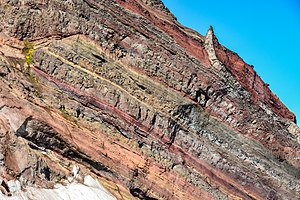
Back Stratovulkaan Afrikaans بركان طبقي Arabic Estratovolcán AST Qarışıq vulkan Azerbaijani Gunung Api Kojong BAN Estratobulkan BCL Стратавулкан Byelorussian Стратавулькан BE-X-OLD Стратовулкан Bulgarian মিশ্র আগ্নেয়গিরি Bengali/Bangla


A stratovolcano, also known as a composite volcano, is a typically conical volcano built up by many alternating layers (strata) of hardened lava and tephra.[1] Unlike shield volcanoes, stratovolcanoes are characterized by a steep profile with a summit crater and explosive eruptions.[2] Some have collapsed summit craters called calderas.[3] The lava flowing from stratovolcanoes typically cools and solidifies before spreading far, due to high viscosity. The magma forming this lava is often felsic, having high to intermediate levels of silica (as in rhyolite, dacite, or andesite), with lesser amounts of less viscous mafic magma.[4] Extensive felsic lava flows are uncommon, but can travel as far as 8 km (5 mi).[5]
The term composite volcano is used because strata are usually mixed and uneven instead of neat layers.[6] They are among the most common types of volcanoes;[7] more than 700 stratovolcanoes have erupted lava during the Holocene Epoch (the last 11,700 years),[8] and many older, now extinct, stratovolcanoes erupted lava as far back as Archean times.[9][10] Stratovolcanoes are typically found in subduction zones but they also occur in other geological settings. Two examples of stratovolcanoes famous for catastrophic eruptions are Krakatoa in Indonesia (which erupted in 1883 claiming 36,000 lives)[11] and Mount Vesuvius in Italy (which erupted in 79 A.D killing an estimated 2,000 people).[12] In modern times, Mount St. Helens (1980) in Washington State, US, and Mount Pinatubo (1991) in the Philippines have erupted catastrophically, but with fewer deaths.[7]
- ^
 This article incorporates public domain material from Principal Types of Volcanoes. United States Geological Survey. Retrieved 19 January 2009.
This article incorporates public domain material from Principal Types of Volcanoes. United States Geological Survey. Retrieved 19 January 2009.
- ^ "Types of volcano". British Geological Survey. Retrieved 24 October 2024.
- ^ "Volcanoes: Principal Types of Volcanoes". United States Geological Survey. Retrieved 24 October 2024.
- ^ Carracedo, Juan Carlos; Troll, Valentin R., eds. (2013). Teide Volcano: Geology and Eruptions of a Highly Differentiated Oceanic Stratovolcano. Active Volcanoes of the World. Berlin Heidelberg: Springer-Verlag. ISBN 978-3-642-25892-3.
- ^ "Lava flows destroy everything in their path | U.S. Geological Survey". United States Geological Survey. Retrieved 24 October 2024.
- ^ "Composite Volcanoes (Stratovolcanoes) (U.S. National Park Service)". National Park Service. Retrieved 24 October 2024.
- ^ a b "Stratovolcano | Shape, Examples, & Facts | Britannica". Encyclopædia Britannica. 28 September 2024. Retrieved 24 October 2024.
- ^ "Holocene Volcano List". Volcanoes of the World (version 5.2.4). Smithsonian Institution Global Volcanism Program. 21 October 2024. Retrieved 3 November 2024.
- ^ "Pleistocene Volcano List". Volcanoes of the World (version 5.2.4). Smithsonian Institution Global Volcanism Program. 21 October 2024. Retrieved 3 November 2024.
- ^ Lambert, M.B. (2005). "Back River Volcanic Complex: An Archean Stratovolcano, Nunavut-Northwest Territories" (PDF). Geological Survey of Canada Bulletin 581.
- ^ "On This Day: Historic Krakatau Eruption of 1883". National Centers for Environmental Information (NCEI). 25 August 2017. Retrieved 24 October 2024.
- ^ "Vesuvius Erupts". American Museum of Natural History.